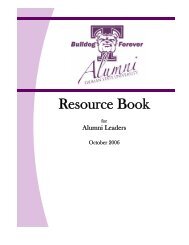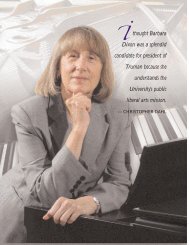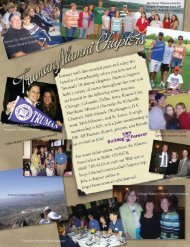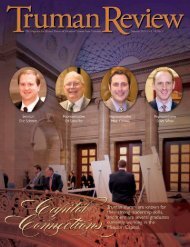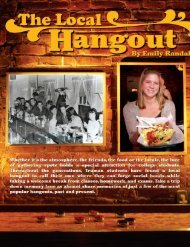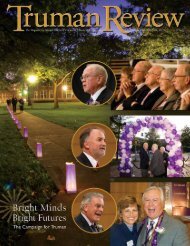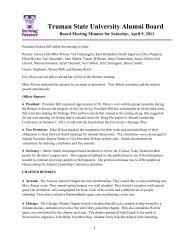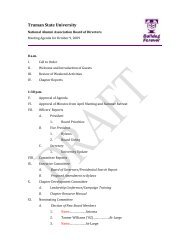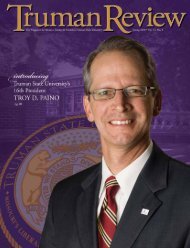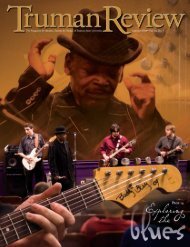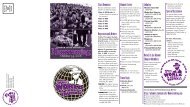Model Rural School - Alumni - Truman State University
Model Rural School - Alumni - Truman State University
Model Rural School - Alumni - Truman State University
Create successful ePaper yourself
Turn your PDF publications into a flip-book with our unique Google optimized e-Paper software.
Almost everyone has heard the story from a<br />
relative or two recounting life growing up on a<br />
farm and how many miles he or she walked to<br />
their country schoolhouse. Driving through<br />
the countryside today, one can still spot these<br />
distinctive little white buildings, though most<br />
are now abandoned. Back in the early 1900s,<br />
<strong>University</strong> President John R. Kirk’s crusade<br />
for a complete and practical rural schoolhouse<br />
helped change the course of rural education.<br />
A horse-drawn covered<br />
wagon collected children<br />
from around rural Adair<br />
County and delivered them<br />
to and from the <strong>Model</strong><br />
<strong>Rural</strong> <strong>School</strong> House that<br />
was built on the <strong>University</strong><br />
grounds in 1907. The building<br />
burned down in 1937.
Nowadays, <strong>Truman</strong> <strong>State</strong> <strong>University</strong> is known as a public liberal arts and<br />
sciences institution, but in the fall of 1899 when John R. Kirk became the<br />
fifth president of the <strong>University</strong>, the primary mission of the college was to<br />
prepare teachers to teach in public schools. Having attended a rural school<br />
as a young boy and then working in the field of education as an adult, Kirk<br />
recognized the shortcomings of many of the rural schools in existence at<br />
that time.<br />
A contemporary quoted in <strong>University</strong> President Walter Ryle’s Centennial<br />
History book provides this grim description of the typical rural schoolhouse<br />
at that time in history: “The box-car type of building erected without any<br />
consideration for the health and comfort of children; surroundings, a small<br />
yard, bleak and bare...unequipped laboratory and library; short terms; illpaid<br />
teachers; irregular attendance; antiquated and inefficient curriculum.”<br />
Kirk’s dream was to remedy this situation by establishing country schools<br />
with well-equipped facilities that provided opportunities for students that<br />
were equivalent to those available in the city schools.<br />
While serving as state superintendent of public schools during the 1890s<br />
before becoming president of the <strong>University</strong>, Kirk had traveled throughout<br />
Missouri and other states and had searched for an example of a rural<br />
school that could serve as a model for others. Not finding what he considered<br />
the ideal rural school, he began a series of experiments eventually<br />
devising his own plans for a school building, as well as modernized educational<br />
programming designed specifically for rural students. His plans took<br />
into consideration how to build the school economically and efficiently, and<br />
how to also provide for modern conveniences such as electricity, gas, and<br />
hot and cold running water in buildings that would be constructed away<br />
from town.<br />
Fall 2004 7
The <strong>Model</strong> <strong>Rural</strong> <strong>School</strong> House was located south of the Kirk<br />
Building, seen on the left side of the photo below.<br />
Based on Kirk’s plans, a <strong>Model</strong> <strong>Rural</strong> <strong>School</strong> was erected<br />
on the <strong>University</strong> grounds near the south entrance of the<br />
Kirk Building, and the school opened its doors in 1907 to<br />
a class of 28 students. “The building differs materially in<br />
appearance, both inside and outside, from the old style<br />
country school house,” wrote E.M. Violette, who served as<br />
a member of the <strong>University</strong> faculty from 1900-1923 and<br />
who wrote a paper about the rural school built on campus.<br />
“Instead of presenting a forbidding aspect as does the old<br />
style type with its low roof, its single entrance in the middle<br />
of the front end, and its windows along the two sides, this<br />
<strong>Model</strong> <strong>Rural</strong> <strong>School</strong> House appears inviting and suggests at<br />
the outset commodiousness and style as well as utility. . .”<br />
In his paper, Violette also provides a detailed description<br />
of the school that illustrates Kirk’s meticulous attention to<br />
details. “The school room, which is 22 x 27 feet, is<br />
arranged so that the pupils sit facing the east to receive<br />
the light over their left shoulders from windows in the<br />
north wall,” wrote Violette, who also notes that inquiries<br />
came from far and near concerning the school. Journalists<br />
and educators from around the country visited Kirksville to<br />
see Kirk’s plan in action, and as a result, many school<br />
buildings in Missouri and other states were patterned after<br />
the school.<br />
“I believe schools all over the country used his curriculum<br />
and operations model; one of the most prominent was<br />
Porter <strong>Rural</strong> <strong>School</strong> just outside of Kirksville,” says Elaine<br />
Doak, head of Special Collections/archivist at <strong>Truman</strong>’s<br />
Pickler Memorial Library. “Marie Turner Harvey, who ran<br />
our model school for a time, went to Porter and revamped<br />
it according to what was done here.”<br />
The Porter <strong>School</strong> was operated from 1907 until 1967,<br />
and the Adair County Public Library has a collection of<br />
materials that records the school’s history. The description<br />
for the Porter <strong>School</strong> Collection says, “Progressives<br />
searched for ways to address the new problems in society<br />
created by the rapid industrial expansion of the late 19th<br />
century. Progressive programs shared the common belief<br />
that environment is the primary influence on behavior.<br />
Porter <strong>School</strong> became a demonstration of the progressives’<br />
commitment to education as a way of restoring vitality<br />
to rural America. . .”<br />
Rick Riley, a 1974 <strong>Truman</strong> alumnus attended the Porter<br />
<strong>School</strong> from 1957 to 1965, and remembers how they<br />
had grades one through eight in one classroom. “We usually<br />
averaged around 28 or 30 students with three or four<br />
students in each grade,” says Riley. His teacher, Marlene<br />
Winslow, would go around and spend individual time with<br />
each class throughout the day. “One group might have<br />
reading with the Dick and Jane and Spot books in the<br />
morning, and another group might have algebra and<br />
math or spelling in the afternoon,” says Riley.<br />
8 <strong>Truman</strong> Review
The rural schools became a part of the rural community,<br />
and Riley recalls the parents attending meetings at Porter<br />
<strong>School</strong> while the children played outside. “There’s a lot of<br />
history there and lots of fun memories,” says Riley, who<br />
feels fortunate that he had the opportunity to attend<br />
Porter <strong>School</strong> for his first eight years of schooling. “I<br />
came to school in town for the ninth grade, and I was<br />
really pretty much prepared, maybe even better prepared<br />
than others,” says Riley.<br />
“Teachers and students at these schools formed strong<br />
communities of learners, and there were opportunities for<br />
cross-age teaching and peer tutoring - teachers knew their<br />
students well and made instructional decisions on the<br />
spot,” says Sam Minner, head of the Division of<br />
Education at <strong>Truman</strong>. “On the down side, in some cases<br />
teachers in these schools knew little about some disciplines<br />
- no one is an expert in everything - but it was a<br />
problem if your teacher was great in literature, but at a<br />
loss in math.” Minner says another drawback was professional<br />
isolation for the teacher.<br />
As time passed by, the need for these small rural schoolhouses<br />
began to diminish. “The demise of the one-room<br />
school was caused by many things, but chief among them<br />
was an interest in providing American students with a<br />
broader range of subjects,” says Minner, who notes that<br />
one-room schoolhouse teachers not only taught, but they<br />
served as janitors and disciplinarians. In an attempt to<br />
professionalize teaching, others were ultimately hired to<br />
do some of these non-teaching tasks. In addition, Jeff<br />
Gall, associate professor of history, says that better roads<br />
in the 1920s and beyond made it possible to consolidate<br />
schools. “Educators believed they could pool resources of<br />
local schools and create a far superior model – they were<br />
probably right.”<br />
Like so many other rural schoolhouses, the <strong>Model</strong><br />
<strong>Rural</strong> <strong>School</strong> on campus represented a passing phase<br />
in American education. “They stopped using the building<br />
as a school during or shortly after World War I,” says<br />
Doak. The original building burned down in 1937, and<br />
another building, constructed on the same site, was later<br />
sold and moved.<br />
The <strong>Model</strong> <strong>Rural</strong> <strong>School</strong><br />
was designed in response<br />
to a growing movement to<br />
improve the educational<br />
environment in the country<br />
schools during the early<br />
1900s. Modern conveniences<br />
were factored into<br />
the design that also considered<br />
the comfort of the<br />
students. Adjustable desks<br />
made it possible to accommodate<br />
the various age<br />
groups, and care was<br />
taken to position the desks<br />
to take advantage of the<br />
natural sunlight that<br />
streamed in through the<br />
windows.<br />
<strong>University</strong> President John R. Kirk carried a dollhouse-sized<br />
replica of the <strong>Model</strong> <strong>Rural</strong> <strong>School</strong> on speaking tours. The<br />
demonstration model could be disassembled so that Kirk<br />
could explain the details of his design.<br />
Fall 2004 9



